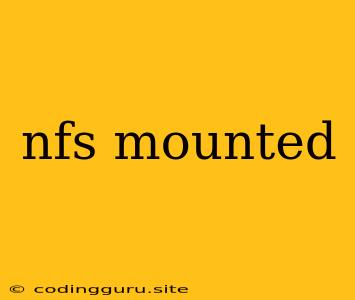NFS Mounted: A Comprehensive Guide to Network File System Mounts
The Network File System (NFS) is a distributed file system protocol that allows users on a network to access files on a remote server as if they were local. This powerful functionality makes it a popular choice for sharing data between computers, especially within a local area network (LAN). Understanding how NFS mounts work is crucial for effectively utilizing this technology.
What does "NFS Mounted" Mean?
"NFS Mounted" signifies that a remote file system (located on an NFS server) has been successfully connected and made accessible to your local system. This connection allows you to read, write, and manage files on the shared server as if they were on your local machine.
Why Use NFS Mounts?
NFS mounts offer several advantages:
- Centralized Storage: Consolidate data storage on a dedicated server, simplifying file management and backups.
- Shared Access: Allow multiple users and machines on your network to access the same data simultaneously, fostering collaboration.
- High Availability: Utilize redundant servers to ensure continuous data access even if one server experiences problems.
- Scalability: Easily scale storage capacity by adding more servers to the NFS network.
How to Mount an NFS Share
Mounting an NFS share involves the following steps:
- Identify the NFS Server: Determine the IP address or hostname of the server hosting the share.
- Locate the Export Directory: Find the specific directory on the server that you wish to mount.
- Configure the Mount Point: Choose a local directory on your machine where the shared files will be accessed.
- Use the
mountCommand: Utilize themountcommand with appropriate options to connect the share to your local system.
Here's a basic example of mounting an NFS share using the mount command:
sudo mount -t nfs :
Example:
sudo mount -t nfs 192.168.1.10:/data /mnt/nfs
This command mounts the /data directory on the server with the IP address 192.168.1.10 to the /mnt/nfs directory on your local system.
Understanding Mount Options
The mount command offers several options for controlling how NFS mounts are configured. These options can affect security, performance, and other aspects of the mount. Some common options include:
-t nfs: Specifies the file system type as NFS.-o ro: Mounts the share in read-only mode.-o rw: Mounts the share in read-write mode (default).-o vers=3: Specifies NFS version 3.-o vers=4.0: Specifies NFS version 4.0.-o vers=4.1: Specifies NFS version 4.1.-o hard: Uses a hard mount, which will block access to the local machine until the NFS server becomes available.-o soft: Uses a soft mount, which will allow access to the local machine even if the NFS server is unavailable.-o nolock: Disables locking mechanisms on the shared files.
Troubleshooting NFS Mounts
If you encounter issues with mounting an NFS share, there are several things you can check:
- Permissions: Verify that the NFS server is properly configured to allow access to the desired directory.
- Network Connectivity: Ensure that your local machine can communicate with the NFS server.
- Firewall Rules: Check if any firewalls are blocking NFS traffic.
- Mount Options: Make sure the mount options are correctly specified.
- Server Availability: Confirm that the NFS server is running and accessible.
Un-mounting an NFS Share
To detach an NFS share from your local system, use the umount command:
sudo umount
Example:
sudo umount /mnt/nfs
This command unmounts the NFS share mounted at /mnt/nfs.
Automounting NFS Shares
For convenience, you can configure your system to automatically mount NFS shares at startup. This eliminates the need to manually mount the shares every time you log in.
To achieve this, you can edit the /etc/fstab file on Linux systems and add an entry for each NFS share. This entry will contain information about the server, export directory, mount point, file system type, and various mount options.
Example:
192.168.1.10:/data /mnt/nfs nfs defaults 0 0
This entry instructs the system to automatically mount the /data directory on the server with the IP address 192.168.1.10 to the /mnt/nfs directory on your local system.
Security Considerations
NFS mounts can expose your data to unauthorized access. Implement strong security measures to protect your NFS shares:
- Secure the NFS Server: Utilize robust passwords, enable authentication mechanisms like Kerberos, and configure access control lists (ACLs) on the NFS server.
- Secure the Network: Utilize network security measures such as firewalls and VPNs to protect your network from unauthorized access.
- Limit Access: Grant only necessary access permissions to users and machines.
- Regularly Monitor: Actively monitor your NFS server for any unusual activity or security breaches.
Conclusion
NFS mounts offer a powerful way to share files and data across a network, providing centralized storage, shared access, and scalability. Understanding the fundamentals of NFS mounting, including the mount and umount commands, mount options, security considerations, and automation techniques, will allow you to effectively leverage this technology for your network needs.
